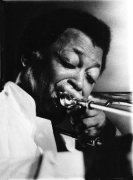 |
Curtis FullerTrombone |
|---|
 |
Curtis FullerTrombone |
|---|
"Curtis has buckets and buckets and tons of soul. He has wonderful natural qualities and is bound to mature into a very important voice."
--Gigi Gryce
Curtis Fuller was born in Detroit, Michigan in 1934. He came to music late, playing the baritone horn in high school and switching to the trombone at age 16. Detroit, at the time, was the breeding ground for an astonishing pool of fresh, highly individual talent.
Milt Jackson and Hank Jones had already gone to New York and made their names. But coming of age in Detroit in the early fifties were Fuller, Donald Byrd, Elvin and Thad Jones, Paul Chambers, Louis Hayes, Kenny Burrell, Barry Harris, Pepper Adams, Yusef Lateef, Sonny Red, Hugh Lawson, Doug Watkins, Tommy Flanagan and many others who would make the mid-decade migration to New York and eventually international recognition.
In 1953, Curtis left the local scene to serve his two-year stint in the army, where he met and played with Cannonball Adderley and Junior Mance among others. When he returned home, he began working with Yusef Lateef's quintet. The Lateef quintet came to New York in April 1957 to record two albums for Savoy and a third produced by Dizzy Gillespie for Verve.
Word of Curtis's talent spread rapidly around New York. Although he initially came under the spell of J.J. Johnson and listed Jimmy Cleveland, Bob Brookmeyer and Urbie Green among his favorites, Fuller came to New York at the age of 22 with a unique style and sound.
In May, after being in town for about a month, he recorded with Paul Quinchette and made his first albums as a leader: two quintet albums for Prestige with Sonny Red featured on alto. Like the Blue Note debuts by Kenny Burrell and Thad Jones the prior year, he used mostly transplanted Detroit players.
Blue Note's Alfred Lion had also heard about Fuller and went to see him at the Cafe bohemia with Miles Davis's sextet. Curtis joined the Blue Note family, appearing on a Clifford Jordan date on June 2 and making his own, The Opener, with Hank Mobley, on June 16. That summer Curtis was everywhere. "Alfred brought me into dates with Jimmy Smith and Bud Powell. And then we did Blue Train with John Coltrane. And I became the only trombone soloist to record with those three artists." So after eight months in New York, Curtis Fuller had made six albums as a leader and appeared on 15 others. Even in those prolific times, that's pretty impressive for a newly-arrived trombonist.
At the end of '58, Benny Golson asked Curtis to share the front line for a Riverside blowing date entitled "The Other Side Of Benny Golson," which put the emphasis on Benny's tenor playing rather than his composing and arranging. The chemistry between these two hornmen clicked, and they would record an album under Curtis's name for Savoy [Blues-ette] and three under Benny's name for Prestige in 1959 with various rhythm sections. They also made two Fuller albums for Savoy with trumpet added to the front line, which laid the groundwork for the creation of the Jazztet.
In February 1960, the Jazztet, a sextet under the leadership of Benny Golson and Art Farmer, made their first album. Curtis Fuller was the trombonist and McCoy Tyner made his recording debut as the pianist. The Jazztet became a very successful unit from the start, but Fuller and Tyner left a few months into the life of the band. They were headed in other directions.
In the summer of '61, Curtis made Art Blakey's Jazz Messengers a sextet for the first time. The combined writing and playing talents of Fuller, Freddie Hubbard, Wayne Shorter and Cedar Walton, driven by Blakey and Jymie Meritt (later Reggie Workman), created one of the most exciting and distinctive bands in the history of hard bop.
Curtis stayed with the Jazz Messengers until February 1965. He spent the rest of that decade freelancing around New York, adding his beautiful sound to a number of Blue Note dates such as Lee Morgan's Tom Cat, Hank Mobley's A Caddy For Daddy, Joe Henderson's Mode For Joe and Wayne Shorter's Schizophrenia.
After some health problems, Curtis is active again. What is as remarkable about Curtis Fuller as his lyrical improvising and ingenious writing, is his personality. On the road, on stage, or in the studio, Curtis is a relaxed professional who lifts every situation with his inredible sense of humor and his natural sparkle.
--MICHAEL CUSCUNA, from the liner notes,
The Complete Blue Note/United Artists
Curtis Fuller Sessions, Mosaic.
A selected discography of Curtis Fuller albums.
| Find Curtis Fuller on Amazon.com | Find Curtis Fuller on eBay.com | |
|---|---|---|
| Curtis Fuller CDs on Amazon | Curtis Fuller CDs on eBay | |
| The Jazztet CDs on Amazon | Curtis Fuller LPs on eBay | |
| One Night with Blue Note, DVD, 1985. | Curtis Fuller BOOKs on eBay | |
| Curtis Fuller DVD / VHS on eBay |
 Music |
 Home |
 Musicians |
|---|
|
Any comments, additions or suggestions should be adressed to:
The Hard Bop Homepage / Eric B. Olsen / ebolsen@juno.com |
Other Web Sites:
The Film Noir 'net A History of Horror The War Film Web Author Eric B. Olsen |